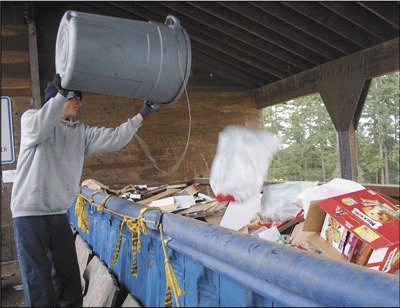Since county transfer stations upped garbage tipping fees and started charging for recycling, rumors have been flying: people are burning or burying their refuse in the woods instead of bringing it in for proper disposal.
County Solid Waste Manager Steve Alexander says neither is actually happening — at least, not en masse.
“There’s an urban myth that people are burying their garbage — that’s a lot of work,” Alexander said. “Show me someone who’s burying their garbage, and I’ll show you someone who’s unstable; and burning is something you cannot hide [because of the smell].
Alexander said county-wide recycle volume has dropped only 7 percent since the county began charging to accept recycling in October 2010. From March through June of 2010, the county received 977.30 tons of commingled recyclables; during that same period in 2011, the county took in roughly 70 tons less.
While it appears that most people are still recycling, there’s one rumor that appears to be true: the amount of garbage dropped at county transfer stations is still in decline. Alexander said transfer station operators in Skagit, Whatcom and Island counties occasionally tell him they’re seeing loads from San Juan County.
“There are people organizing neighborhoods where someone with a big rig just takes everybody’s garbage,” Alexander said. “It’s against county ordinance, but they do it anyway. This is where people seem to be taking the action that they’re verbalizing.”
Since peaking at 12,798 tons in 2007, county garbage tonnage has declined steadily to 12,590 tons in 2008; 10,350 tons in 2009; and 8,580 tons in 2010; with just 7,000 tons anticipated for all of 2011.
The Town of Friday Harbor and the waste generated within its boundaries have played a role in the decline.
As a municipality, the town is not required to use county transfer stations. In mid-July 2010, it began hauling its residential garbage to a Skagit County solid waste facility. Based on the town’s average annual contribution of 1,700 tons, Alexander estimates the county lost 700 tons of town residential garbage in 2010.
But even if the county had received the town’s trash, the county’s 2010 annual total would have been 9,290 tons, and its 2011 total would have been roughly 8,700 tons.
“Overall we’re having a drop in our garbage that’s not explained by any national trends or anything other than what we call leakage,” said Alexander, or people hauling their trash outside the county.
Alexander said that while nationwide per capita garbage production has begun to see a small uptick, San Juan County’s waste stream continues to dwindle. He added that construction and remodeling debris “dried up” some time ago, so he doesn’t see lack of construction activity as a reasonable cause for the continued decline.
From March to June 2010, the Town of Friday Harbor processed 541.32 tons of trash; during that same period in 2011 it received 559.13 tons, a 3.3 percent increase. Town Administrator King Fitch estimates the town still takes 90 percent of its recycle to county transfer stations, selling the remainder as scrap metal.
Between March-June 2010 and March-June 2011, the town’s cardboard volume rose 15 percent, while colored paper volume dropped 22 percent. (Other recycling comparison numbers were unavailable.)
The October 2010 flat $5 fee for recycling was upped in January 2011 to $5 for six cans; $25 for up to six cubic yards; and $50 for larger loads. In July 2011 those recycle fees were reduced to $5, $10 and $25, respectively. The effect of this particular shift is unclear.
Alexander chose the March-June data range in part to account for the fact that Lopez Island, which had been sorting its recycling in prior months, began commingled recycling with the rest of the county in March 2010.




